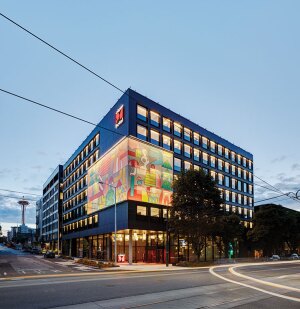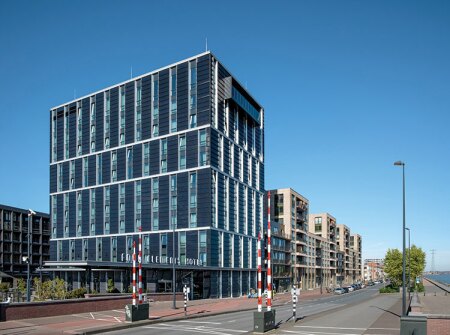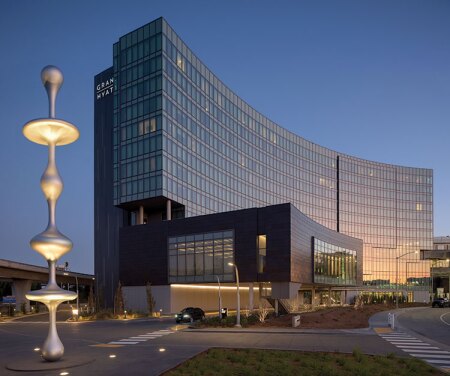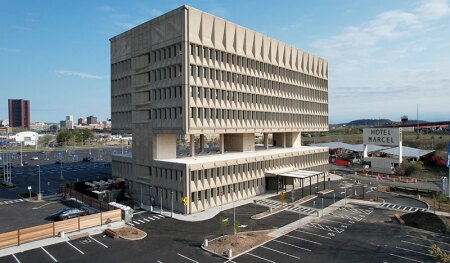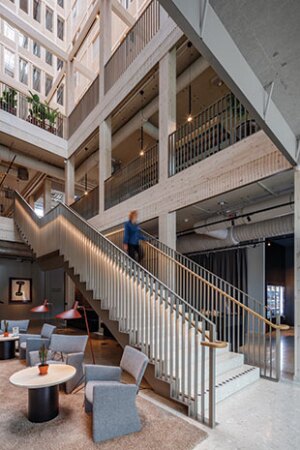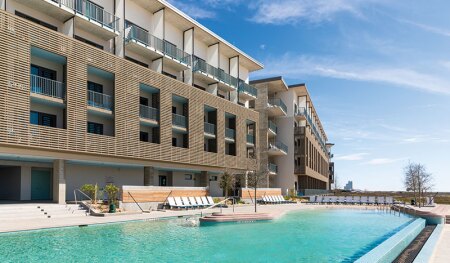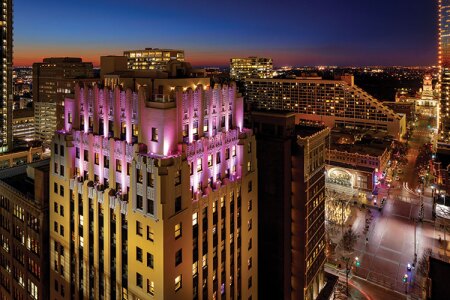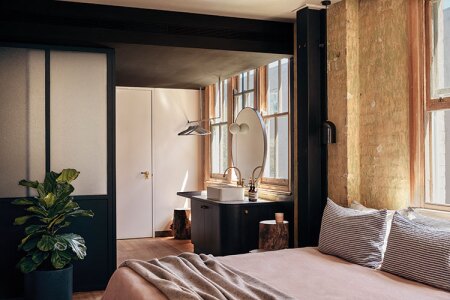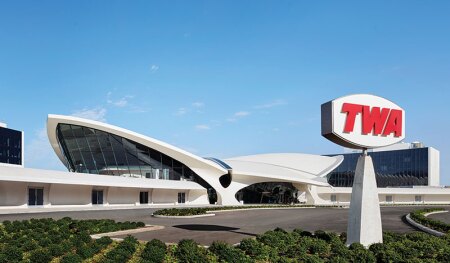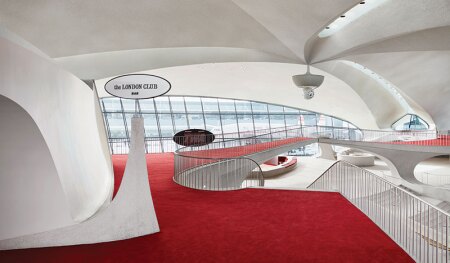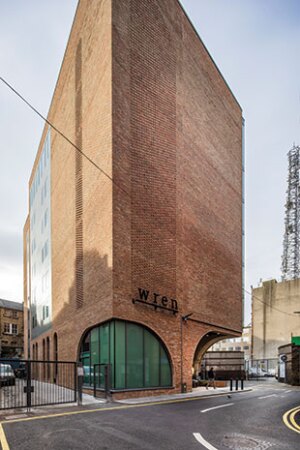These 10 hotels embody environmental sensitivity plus energy and water efficiency.
Hotels consume more energy and water per square foot than just about any other building type, according to the ULI report Sustainability in Hotels: Opportunities and Trends Shaping the Future of Hospitality. At the same time, guests are paying closer attention to a hotel’s environmental impact when choosing where to stay. As an additional incentive, design strategies that cut energy and water consumption pay off in lower utility bills.
The following 10 projects—all completed during the past five years—include adaptations of a film warehouse, a tire factory, an airport terminal, and an oil company’s headquarters, as well as newly constructed buildings that reduce energy waste with ethernet cables, integrate photovoltaics into their facades, and deploy cooling methods borrowed from African termites.
RON NYREN is a freelance architecture and urban design writer based in the San Francisco Bay area.
1. CitizenM Seattle South Lake UnionSeattle, Washington
Amsterdam-based CitizenM opened its first West Coast hotel in Seattle’s South Lake Union neighborhood in 2020. The seven-story building consists of 264 rooms in modular units that were prefabricated and finished off site, a strategy that minimizes construction waste as well as cost. The local office of engineering firm Arup adapted the modular cage design of other citizenM hotels to meet the stringent requirements of local seismic codes.
The heating and cooling system conserves energy by relying on an active chilled beam in each room, a dedicated outdoor air supply, and heat pumps that capture excess heat to pre-warm domestic hot water. CitizenM’s smartphone app allows guests to check in, open the room’s doors, and control the lighting, blinds, room temperature, and entertainment options. An art piece by local artist Jesse LeDoux wraps a corner of the facade. The hotel was designed by the Amsterdam-based design firm Concrete in collaboration with the local office of Gensler.
2. Four Elements HotelIJburg, Netherlands
Ben Bronsema of Voorschoten, Netherlands, studied the techniques that African termites use to moderate temperatures inside their mounds. The Four Elements Hotel draws on his findings, relying on the sun and wind to heat and cool its 198 guest rooms as a kind of natural air-conditioning system. The 11-story structure has two solar chimneys facing southwest. These glazed vertical voids use sunlight to heat air, which rises through a heat exchanger that captures it for the building’s water supply. An underground thermal energy storage area captures any excess warmth for later use.
As the warm air rises, it draws outside air down through another vertical shaft, the “climate cascade,” where sprays of water cool or heat it for ventilation. This passive design strategy reduces the need for mechanical fans. Guests can control their room temperatures and the level of air flow. Photovoltaic cells cover the facade, rooftop, and canopies to provide energy. Completed in 2019, the hotel was designed by Amsterdam firms OZ and NwA architecten and Stockholm-based Doos Architects for developers Amstelius/Dutch Green Company of Amsterdam and Borghese Real Estate of Nijkerk, Netherlands.
3. Grand Hyatt at SFOSan Francisco, California
The only on-airport hotel at San Francisco International Airport, the Grand Hyatt at SFO provides views of airplanes landing nearby through its curved glass facade. Designed to be 26 percent more energy efficient than a typical hotel of the same size, the building has rooftop photovoltaic panels that generate 133,000 kilowatt-hours of electricity each year. Occupancy sensors power down lighting, heating, and cooling in rooms when guests are absent in order to lower electricity consumption.
Low-flow faucets and shower heads, cooling towers with high-performance water-flow controls, and efficient-flush toilets are estimated to save 6.7 million gallons (25.4 million liters) of water each year. The hotel’s dual plumbing system will enable it to use reclaimed water for toilet flushing and irrigation. Guests can reach the hotel via an automated people mover that also connects to rapid transit and local and regional bus service lines. Designed by local firm Hornberger + Worstell with its associate ED2I, the hotel opened in 2019.
4. Hotel Marcel New Haven, Tapestry Collection by HiltonNew Haven, Connecticut
When noted modernist architect Marcel Breuer designed a brutalist structure for the Armstrong Rubber Company in 1967, he inserted a two-story void between the research labs on the lower levels and the offices above, shielding offices from noise and giving the building its distinctive profile at the intersection of two interstate highways. Though listed on the National Register of Historic Places, the structure (later the Pirelli Tire Building) was largely abandoned in the late 1990s until local architect/developer Bruce Redman Becker’s firm Becker + Becker purchased it in 2020. Becker adapted the concrete building as the Hotel Marcel with the goal of creating a net zero energy hotel.
Opened in 2022, the all-electric, 165-room hotel relies on a rooftop solar array as well as solar canopies over the parking area to generate all its electricity. A power-over-ethernet (PoE) lighting system minimizes the amount of energy required for lighting. High levels of insulation and triple-glazed windows keep heating and cooling costs low. The design team, which also includes Brooklyn-based interior designer Dutch East Design, retained existing board-formed concrete and repurposed other building materials from the site, including light fixtures and wood-paneled walls.
5. House of ChoiceSolna, Sweden
In the Arenastaden neighborhood of Solna, the House of Choice brings 336 hotel rooms, 88 long-stay apartments, and offices for the Swedish headquarters of Oslo-based Nordic Choice Hotels under one roof—a roof with a sawtooth shape that maximizes the amount of energy its photovoltaic panels can generate. The entry facade, which faces south, is also covered with solar panels made of different sheets of glass: dark gray and ribbed, dark gray and smooth, and pearl beige. Etching on the solar panel glazing adds further visual interest.
Solar panels are also integrated into the roof of the light-well courtyard. A ground-source heat pump system with 25 boreholes supplies cooling and heating. Opened in 2021, the building is targeted to generate more electricity than it consumes. White Architekter of Gothenburg, Sweden, designed the building for Solna-based developer Fabege and Nordic Choice Hotels.
6. Lodge at Gulf State ParkGulf Shores, Alabama
Gulf State Park Lodge opened on state parklands on the Gulf of Mexico in 1974; 30 years later, Hurricane Ivan destroyed it. The site was abandoned until another disaster, the Deepwater Horizon oil spill, ironically provided settlement funds to build a new lodge and heal the surrounding dune ecology. Sasaki of Watertown, Massachusetts, oversaw restoration of the 6,150-acre (2,490 ha) park. The existing manmade dune was removed and dune grass planted to encourage the natural growth of sand dunes, enhance wildlife habitat, and protect the site from future storm surges.
Lake/Flato of San Antonio and Rabun Architects of Atlanta designed the new five-story, 350-room lodge on a much more compact footprint than that of its predecessor, set well back from the Gulf. Shaded porches and natural ventilation moderate temperatures inside. Pervious parking lots allow stormwater to percolate into the ground, and air-conditioning condensation is collected, filtered, and used to supplement water in the swimming pool. Guests have access to new trails and a 900-acre (364 ha) freshwater fishing lake. Operated by Hilton, the lodge opened in 2018.
7. The Sinclair, Autograph CollectionFort Worth, Texas
Sinclair Oil Holdings built its 17-story Fort Worth headquarters in 1929 with a zigzag moderne exterior and art deco interiors, embodying the Texas oil boom’s exuberance. More than 90 years later, the structure has found new life as a hotel with cutting-edge energy-saving technology. Farukh Aslam, chief executive officer of local company Sinclair Digital, purchased the building in 2013 and chose a PoE system to supply electricity for lighting, automatic window shades, smart mirrors, and minibars. Because PoE reduces the energy loss that comes from converting AC power to DC, the light fixtures also run much cooler, relieving strain on the air-conditioning system.
The system is estimated to reduce the hotel’s energy use by more than 30 percent. Occupancy sensors and smart thermostats conserve electricity as well. Opened in 2020, the hotel forgoes a diesel generator in favor of a lithium-ion battery as its backup system during power outages. Dallas-based Merriman Anderson Architects renovated the exterior, and the Dallas office of Forrest Perkins handled interior design.
8. Paramount House HotelSydney, Australia
In the Surry Hills neighborhood of Sydney, local developer Citadin repurposed the 1940s art deco headquarters of Paramount Pictures Australia as the Paramount House, containing a cinema, bar, café, and coworking space. In 2018, Citadin revamped the adjoining 80-year-old film warehouse as the 29-room Paramount House Hotel. Architecture firm Breathe of Brunswick, Victoria, topped the three-story brick warehouse with a copper screen to give guest-room balconies privacy from the street while filtering daylight. The screen’schevron patterning references the streamline moderne style of the Paramount House next door.
The design team minimized building waste by using locally sourced and recycled materials, such as recycled timber floorboards. Historic brickwork is exposed, with remnants of former stairwells, parapets, gable ends, and joists visible in places. Every guest room is different in shape. A former film-vault-turned-atrium contains the reception lounge. On the roof, a seven-kilowatt photovoltaic array contributes to the building’s electricity supply.
9. TWA HotelNew York, New York
When the TWA Flight Center opened in 1962 at JFK International Airport, its design, by noted modernist architect Eero Saarinen, embodied flight in the building’s sweeping curves. The air terminal closed in 2001, its future uncertain. The Port Authority of New York restored core interior spaces, and the local office of hotel owner/operator MCR/Morse Development added an underground event space and deferentially set new hotel wings back from the historic structure, which houses restaurants, shops, a ballroom, and a fitness center. A triple-glazed curtain wall provides both thermal and acoustic insulation.
Opened in 2019, the hotel produces all its own energy with a highly efficient cogeneration plant that runs on natural gas and recaptures engine heat for hot water and space heating. Ultra-low-flow water fixtures reduce water use. Roof and plaza drains pump stormwater into the airport’s watershed storm system for filtering. Local firm Beyer Blinder Belle Architects and Planners served as project and preservation architect in a team with Brooklyn-based Lubrano Ciavarra Archi-tects and New York City–based firms INC Architecture & Design and Stonehill Taylor.
10. Wren Urban NestDublin, Ireland
Opened in 2021, the 137-room Wren Urban Nest hotel relies on 100 percent renewable energy by means of a variety of carbon-reduction strategies. Heating and cooling are supplied by air source and water-to-water heat pumps, with help from a high thermal mass, a tight building envelope, and a design that shares solar heat gain from one side of the building with the other during the winter. In warmer months, heat gain is diverted to the building’s hot water system.
The designer, the Dublin studio of BDP, equipped the west elevation with a folded, glazed facade that halves the time of exposure to direct afternoon sunlight at any given period. Smart building technologies turn off lights and heating/cooling as well as automatically close and open blinds when guest rooms are unoccupied. A vegetated roof and a stormwater runoff system help filter and absorb stormwater. The hotel’s kitchen uses induction stoves, and the local community can access the kitchen’s food waste through an app.
More in This Issue:

